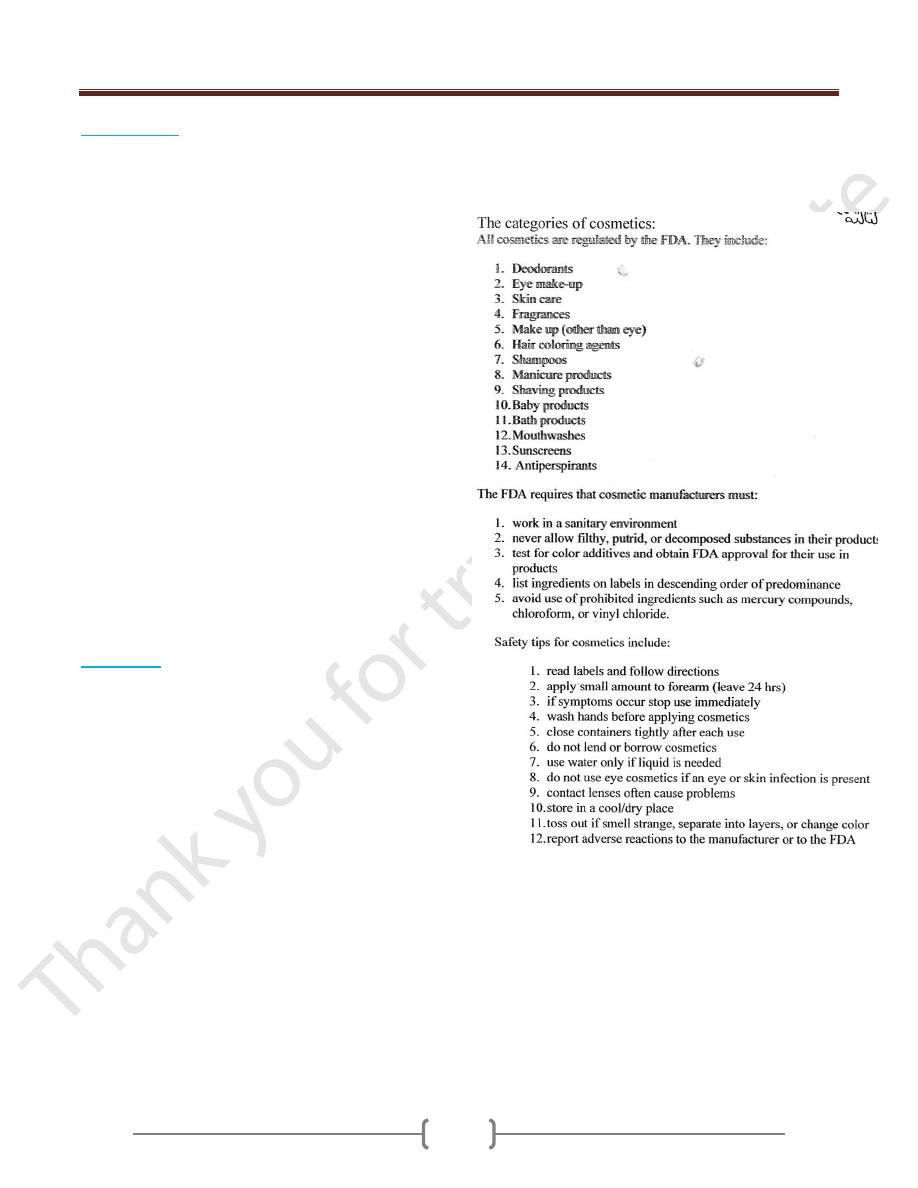
Unit 9: Other lectures not found in decided book
722
Lecture 4+5 - Cosmetics
Cosmetics are care substances used to enhance the
appearance or odor of the human body. They are
generally mixtures of chemical compounds, some being
derived from natural sources, many being synthetic.
The Food and Drug Administration (FDA), which
regulates cosmetics, defines cosmetics as "intended to be
applied to the human body for cleansing, beautifying,
promoting attractiveness, or altering the appearance
without affecting the body's structure or functions." This
broad definition also includes any material intended for
use as a component of a cosmetic product. The FDA
specifically excludes soap from this category.
The word cosmetics derives from ancient Egypt and
Greece. According to one source, early major
developments include.
Castor oil used by ancient Egypt as a protective balm.
Skin creams made of beeswax, olive oil, and
rosewater, described by Romans.
Vaseline and lanolin in the nineteenth century.
Nivea in 1911.
Skin care products
These are products used to improve the appearance and
health of skin, formulated for different types of skin and
associated characteristics. Skin care products include
cleansers, facial masks, toners, moisturizers, sunscreen,
tanning oils and lotions, skin lighteners, serums and
exfoliants.
Skin types
There are five basic skin types, including:
1) Normal skin
This type of skin has a fine, even and smooth surface due
to its ideal balance between oil and moisture content and
is therefore neither greasy nor dry. People who have
normal skin have small, barely-visible pores. Thus, their
skin usually appears clear and does not frequently develop
spots and blemishes. This type of skin needs minimal and
gentle treatment, but does still require maintenance.
2) Dry skin
Dry skin has a parched appearance and tends to flake
easily. It is prone to wrinkles and lines due to its inability
to retain moisture, as well as an inadequate production of
sebum by sebaceous glands. Dry skin often has problems
in cold weather, which dries it out even further. Constant
protection in the form of a moisturizer by day and a
moisture-rich cream by night is essential. gentle exfoliants
using sugar, rice bran or mild acids are the most suitable,
although they should not be used more frequently than
once per week to avoid causing irritation and dryness.
3) Oily skin
This type of skin surface is slightly to moderately greasy,
which is caused by the over secretion of sebum. The
excess oil on the surface of the skin causes dirt and dust
from the environment to adhere to it. Oily skin is usually
prone to blackheads, whiteheads, spots and pimples. It
needs to be cleansed thoroughly every day, especially in
hot or humid weather. Moisturizing with an oil-free,
water-based and non-comedogenic moisturizer is required
in addition. Exfoliation is also necessary, but over-
exfoliation can cause irritation and increase in oil
production; exfoliants that contain fruit acids are
particularly helpful, and fine-grained exfoliants may help
to clear blocked pores, discouraging breakouts and
improving the skin's appearance.
4) Combination skin
This is the most common type of skin. As the name
suggests, it is a combination of both oily and dry or
normal skin, where certain areas of the face are oily and
the others dry. The oily parts are usually found on a
central panel, called the T–Zone, consisting of the
forehead, nose and chin. The dry areas usually consist of
the cheeks and the areas around the eyes and mouth. In
such cases, each part of the face should be treated
according to its skin type. There are also skin care
products made especially for those who have combination
skin; these contain ingredients that cater to both skin
types.
5) Sensitive skin
Sensitive skin has a tendency to react to many potential
triggers with irritation, redness, stinging or burning,
flaking, lumpiness, and rashes. The most common causes
of irritation are chemical dyes and fragrances, soaps,
some flower and spice oils, shaving creams, tanning
lotions or spray tans, changes in temperature, excessive
cleansing or exfoliating, waxing, threading, shaving, and
bleaching. People with sensitive skin should try to avoid
products with unnecessary fragrances or dyes, and
generally avoid using products that cause irritation.
Sensitive skin is typically dry, but can be oily, normal, or
combination as well.

Unit 9: Other lectures not found in decided book
727
General skin care routines
Cleansing
Cleansing is the first essential step to any daily skin care
routine. Cleansers are generally applied to wet skin over
the face and sometimes also the neck, avoiding the eyes
and lips.
Cleansing the face once per day is typically adequate for
normal or dry skins. However, a mild cleanser should also
be used at night if makeup has been worn to remove any
excess dirt or oil. Oily skins should be cleansed more
frequently, at least twice per day. Water-based, gentle
cleansers are ideal for all skin types, though particularly
acne-prone skin may require medicated cleansers
containing benzoyl peroxide or salicylic acid to
discourage acne. While soap can be used as a cleanser, it
should be avoided in cases of dry and sensitive skins;
many alternatives are available. Oil-based cleansers have
become particularly popular with oily skin, as they are
very gentle and do not over-dry the skin, but still
effectively remove dirt and makeup. It is important to
cleanse before applying makeup, regardless of skin type,
as this helps to create a clean surface for makeup
application. Many cleansers are also suitable for use as a
makeup remover, but a proper makeup remover is
preferable, particularly for the removal of eye makeup.
Masks
Face masks are treatments applied to the skin for a period
of time, then removed. Typically, they are applied to a
dry, cleansed face, avoiding the eyes and lips.
There are many kinds of face masks available, which
typically fall into one or more of the following categories:
Clay-based masks use kaolin clay, and are typically left
on until completely dry. As the clay dries, it absorbs
excess oil and dirt from the surface of the skin and may
help to clear blocked pores or draw comedones to the
surface. Because of its drying actions, clay-based masks
should only be used on oily skins.
Peel masks are typically gel-like in consistency, and
contain various acids or exfoliating agents to help
exfoliate the skin, along with other ingredients to hydrate,
discourage wrinkles, or treat uneven skin tone. They are
also left on to dry, and then gently peeled off. They
should be avoided by people with dry skin, as they also
tend to be very drying.
Exfoliants
Exfoliants are products that help to remove dead skin
cells. This is achieved either by using
acids
or
other
chemicals
to loosen old skin cells. Exfoliation can even
out patches of rough skin, improve circulation to the skin,
clear blocked pores to discourage acne and improve the
appearance and healing of scars. Exfoliants should be
applied to wet, cleansed skin, avoiding the eye area;
abrasive exfoliants or scrubs should then be rubbed into
the skin in a circular motion for at least 30 seconds. Dry
skin should only be exfoliated in spots with severe
flaking, and no more than once per week; oily skins may
be able to tolerate twice weekly exfoliation. Signs of
over-exfoliation include sore, dry and irritated or
reddened skin and excessive dryness or oiliness.
Chemical exfoliants may include citric acid (from citrus
fruits), acetic acid (from vinegar), malic acid (from
various fruits), glycolic acid, lactic acid or salicylic acid.
They may be liquids or gels, and may or may not contain
an abrasive to remove old skin cells afterwards. Abrasive
exfoliants include gels, creams or lotions, as well as
physical objects. Loofahs, microfibre cloths, natural
sponges or brushes may be used to exfoliate skin, simply
by rubbing them over the face in a circular motion. Gels,
creams or lotions may contain an acid to encourage dead
skin cells to loosen, and an abrasive such as beads, sea
salt, sugar, ground nut shells, rice bran or ground apricot
kernels to scrub the dead cells off the skin. Salt and sugar
scrubs tend to be the harshest, while scrubs containing
beads or rice bran are typically very gentle.
Toning
Toners are used after cleansing the skin to freshen it up
and remove any traces of cleanser, mask or makeup, as
well to help restore the skin's natural pH. They are usually
applied to a cotton pad and wiped over the skin, but can
also be sprayed onto the skin from a spray bottle.
Toners containing alcohol are quite astringent, and
usually targeted at oily skins. Dry or normal skin should
be treated with alcohol-free toners. Witch hazel solution
is a popular toner for all skin types, but many other
products are available. Many toners also contain
and/or
. These types of toners are
also targeted at oily skin types, as well as acne-prone skin.

Unit 9: Other lectures not found in decided book
722
Moisturizers
Moisturizers are creams or lotions that hydrate the skin
and help it to retain moisture; they may also contain
various essential oils, herbal extracts or chemicals to
assist with oil control or reducing irritation. Night creams
are typically more hydrating than day creams.
All skin types need moisturizing. Moisturizer helps
prevent flaking and dryness, and may help to delay the
formation of wrinkles. People with dry skin should
choose oil-based moisturizers with ingredients to help the
skin retain moisture and protect it from dryness, heat or
cold in the environment. People with normal skin can
choose from a wide variety of moisturizers, but light
lotions or gels are typically all that is required. medicated
moisturizers containing tea tree extracts or fruit enzymes
can help to control oil production or treat acne.
Eyes require a different kind of moisturizer compared
with the rest of the face. The skin around the eyes is
extremely thin and sensitive, and is often the first area to
show signs of ageing. Eye creams are typically very light
lotions or gels, and are usually very gentle; some may
contain ingredients such as caffeine or Vitamin K to
reduce puffiness and dark circles under the eyes. Eye
creams or gels should be applied over the entire eye area
with a finger, using a patting motion.
Protecting
Sun protection is an important aspect of skin care. The
sun can cause extreme damage to the skin, not only in the
form of sunburns and skin cancer; exposure to UVA and
UVB radiation can cause patches of uneven skin tone and
dry out the skin, reducing its elasticity and encouraging
sagging and wrinkle formation. It is important to make
use of sunscreen (like mineral makeup, neutrogena and
light milk) to protect the skin from sun damage; sunscreen
should be applied at least 20 minutes before exposure, and
should be re-applied every four hours. Sunscreen should
be applied to all areas of the skin that will be exposed to
sunlight, and at least a tablespoon (25 ml) should be
applied to each limb, the face, chest, and back, to ensure
thorough coverage. Many tinted moisturizers, foundations
and primers now contain some form of SPF.
Sunscreens may come in the form of creams, gels or
lotions. There are sunscreens available to suit every skin
type; in particular, those with oily skin should choose
non-comodegenic sunscreens; those with dry skins should
choose sunscreens with moisturizers to help keep skin
hydrated, and those with sensitive skin should choose
unscented, hypoallergenic sunscreen and spot-test in an
inconspicuous place (such as the inside of the elbow or
behind the ear) to ensure that it does not irritate the skin.
